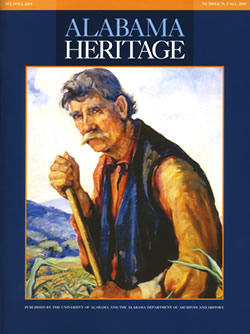|
On the cover: Georgia Mountaineer, oil painting by Martha Anderson, hangs in the Georgia Museum of Art. (Courtesy Georgia Museum, University of Georgia.)
|
FEATURE ABSTRACTS
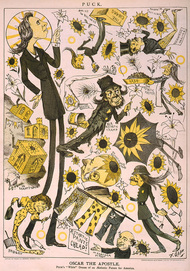 This 1882 cartoon parodies Wilde's
This 1882 cartoon parodies Wilde's attempts to introduce Aestheticism
to America
(Library of Congress Prints
and Photographs Division)
The Wilde Alabama Lecture Circuit
By William Warren Rogers, Dorothy McLeod MacInerney, and Robert David Ward
Throughout the winter and spring of 1882, the Irish-born poet, playwright, and novelist Oscar Wilde conducted a lecture tour of the United States. Wilde’s speeches coincided with performances of Gilbert and Sullivan’s Patience—a comic opera that parodied the excesses and eccentricities of the Aesthetic Movement. Many American audiences viewed Wilde as the embodiment of this controversial “Art for Art’s Sake” philosophy, and nowhere in the country did he face more skepticism than in the post-Reconstruction South. Despite scathing criticism from more than a few journalists, Wilde won over his Alabamian public and left with a special fondness for the state and its people.
By William Warren Rogers, Dorothy McLeod MacInerney, and Robert David Ward
Throughout the winter and spring of 1882, the Irish-born poet, playwright, and novelist Oscar Wilde conducted a lecture tour of the United States. Wilde’s speeches coincided with performances of Gilbert and Sullivan’s Patience—a comic opera that parodied the excesses and eccentricities of the Aesthetic Movement. Many American audiences viewed Wilde as the embodiment of this controversial “Art for Art’s Sake” philosophy, and nowhere in the country did he face more skepticism than in the post-Reconstruction South. Despite scathing criticism from more than a few journalists, Wilde won over his Alabamian public and left with a special fondness for the state and its people.
Additional Information
About the Authors
William Warren Rogers is a native Alabamian and a graduate of Auburn University and the University of North Carolina where he earned his Ph.D. in history. He has been active in teaching, researching, and writing books and articles on the South, concentrating on the three states of Alabama, Georgia, and Florida. He is professor emeritus of history, Florida State University. Among his works are Alabama: The History of a Deep South State (University of Alabama Press, 1994), which he co-authored with Robert David Ward, and The One-Gallused Rebellion: A History of Agrarianism in Alabama, 1865–1896 (University of Alabama Press, 2001).
Dorothy McLeod MacInerney is a native-born Texan who lives with her family in Austin. She received her Ph.D. in history from the University of Texas at Austin, and is interested in southern literary history. She is an independent scholar and has an appointment at the University of Texas.
Robert David Ward was also born in Alabama and attended Auburn University and the University of North Carolina where he got his doctorate in American history. He is a professor emeritus of history at Georgia State University at Statesboro. Ward has published many articles and books about southern history, especially Alabama, many of them co-authored with Rogers. Among Ward’s books are Alabama’s Response to the Penitentiary Movement, 1829–1865 (University Press of Florida, 2003), and the co-authored Alabama: The History of a Deep South State (University of Alabama Press, 1994).
- Baily, Leslie. Gilbert and Sullivan and Their World (Thames and Hudson, 1973)
- Ellman, Richard. Oscar Wilde (Knoph, 1978)
- Holland, Merlin, and Rupert Hart-Davis. The Complete Letters Of Oscar Wilde (Henry Holt and Co., 2000)
- Lewis, Lloyd and Henry Justin Smith. Oscar Wilde Discovers America (Harcourt, Brace, 1936)
- O'Brien, Kevin. Oscar Wilde in Canada: An Apostle for the Arts (Personal Library, 1983)
- White, Terence de Vere. The Parents of Oscar Wilde (Hodder & Stoughton, 1967)
- Ellis, Mary Louise. “Improbable Visitor: Oscar Wilde in Alabama, 1882,” Alabama Review , 39 (October, 1960), 243-60
- Rogers, William Warren, and Robert David Ward, “An Aesthete At Large: Oscar Wilde in Mobile,” Gulf Coast Historical Review, 6 (Spring, 1991), 49-63
- Rogers, William Warren, Dorothy McLeod MacInerney, and Robert David Ward, “Oscar Wilde Lectures in New Orleans and Across the South in 1882,” Southern Studies, 11 (Fall-Winter, 204), 31-65
- Rogers, William Warren, Robert David Ward, and Dorothy McLeod MacInerney, “Aesthetic Messenger: Oscar Wilde Lectures in Memphis, 1882, Tennessee Historical Quarterly, 53 (Winter, 2004), 250-65
- The Official Oscar Wilde Website
- The Oscar Wilde Collection: a selection of online prose, poetry, and drama
- The Trials of Oscar Wilde: website devoted to famous trials, including transcripts from Wilde’s 1895 trial.
- Oscar Wilde: an overview, courtesy of the Victorian Web.
About the Authors
William Warren Rogers is a native Alabamian and a graduate of Auburn University and the University of North Carolina where he earned his Ph.D. in history. He has been active in teaching, researching, and writing books and articles on the South, concentrating on the three states of Alabama, Georgia, and Florida. He is professor emeritus of history, Florida State University. Among his works are Alabama: The History of a Deep South State (University of Alabama Press, 1994), which he co-authored with Robert David Ward, and The One-Gallused Rebellion: A History of Agrarianism in Alabama, 1865–1896 (University of Alabama Press, 2001).
Dorothy McLeod MacInerney is a native-born Texan who lives with her family in Austin. She received her Ph.D. in history from the University of Texas at Austin, and is interested in southern literary history. She is an independent scholar and has an appointment at the University of Texas.
Robert David Ward was also born in Alabama and attended Auburn University and the University of North Carolina where he got his doctorate in American history. He is a professor emeritus of history at Georgia State University at Statesboro. Ward has published many articles and books about southern history, especially Alabama, many of them co-authored with Rogers. Among Ward’s books are Alabama’s Response to the Penitentiary Movement, 1829–1865 (University Press of Florida, 2003), and the co-authored Alabama: The History of a Deep South State (University of Alabama Press, 1994).
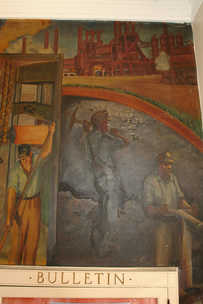 "The Spirit of Steel" depicts
"The Spirit of Steel" depicts the steel manufacturing process
(Lacy Kerr Robinson)
An Artistic Blend: Frank and Martha Anderson
By Lynn Barstis Williams
Photographs by Birmingham photographer Lacy Robinson.
During their marriage, architect Frank Hartley Anderson and artist Martha Fannin Fort not only produced a sizable body of art (both collaborative and individual), but also worked tirelessly to support Alabama’s artistic community. The Andersons, whose various mediums included woodcuts, etchings, portraits, and paintings, created artwork that toured the country, and even the world. Participants in several New Deal Art Programs, the Andersons’ many projects included large educational murals for schools and post offices. By teaching art classes, producing affordable art prints, and undertaking public art projects, the Andersons sought to bring art to all levels of society. Founders of Anderson Galleries and the Southern Printmakers Society, the Andersons ultimately raised national awareness of southern artists.
Additional Information
About the Author
Lynn Barstis Williams is Special Collections and Art Librarian at Auburn University. Her article on the history of Alabama’s Gulf Coast art colonies, which Genevive Southerland organized in Mobile, Bayou la Batre, and Coden, appeared in the May 2000 issue of Gulf South Historical Review. She also has published an article on the Dixie Art Colony in Alabama Heritage, issue 41, Summer 1996. Her book on southern printmakers and their images of the South is forthcoming from the University of Alabama Press.
Errata
• The caption on page 23 of “An Artistic Blend: Frank and Martha Anderson” refers to Lakewood School. The school was actually Lakeview School.
By Lynn Barstis Williams
Photographs by Birmingham photographer Lacy Robinson.
During their marriage, architect Frank Hartley Anderson and artist Martha Fannin Fort not only produced a sizable body of art (both collaborative and individual), but also worked tirelessly to support Alabama’s artistic community. The Andersons, whose various mediums included woodcuts, etchings, portraits, and paintings, created artwork that toured the country, and even the world. Participants in several New Deal Art Programs, the Andersons’ many projects included large educational murals for schools and post offices. By teaching art classes, producing affordable art prints, and undertaking public art projects, the Andersons sought to bring art to all levels of society. Founders of Anderson Galleries and the Southern Printmakers Society, the Andersons ultimately raised national awareness of southern artists.
Additional Information
- Marling, Karal Ann. Wall to Wall America: A Cultural History of Post Office Murals and the Great Depression (University of Minnesota Press, 1982)
- Morris, Philip A. and Marjorie Longenecker White, eds. Designs on Birmingham: A Landscape History of a Southern City and its Suburbs (Birmingham Historical Society)
About the Author
Lynn Barstis Williams is Special Collections and Art Librarian at Auburn University. Her article on the history of Alabama’s Gulf Coast art colonies, which Genevive Southerland organized in Mobile, Bayou la Batre, and Coden, appeared in the May 2000 issue of Gulf South Historical Review. She also has published an article on the Dixie Art Colony in Alabama Heritage, issue 41, Summer 1996. Her book on southern printmakers and their images of the South is forthcoming from the University of Alabama Press.
Errata
• The caption on page 23 of “An Artistic Blend: Frank and Martha Anderson” refers to Lakewood School. The school was actually Lakeview School.
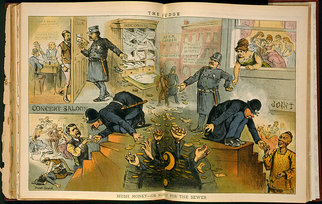 A nineteenth-century cartoon depicts
A nineteenth-century cartoon depictsthe practices involved in obtaining
police protection
(Library of Congress)
Louise Wooster, Birmingham's Magdalen
By James L. Baggett
The most celebrated and philanthropic of Birmingham’s madams, Lou Wooster was a kind and maternal caregiver who also possessed the gifts of storytelling and self-promotion. Born in Tuscaloosa and raised in Mobile, she fell on hard times after her parents’ deaths. She became, at the hands of her gentleman rescuers, first a ward, then a mistress, and “fell, step by step, until at last I was beyond redemption.” Her travels, as recorded in her autobiography, take her from the stage in New Orleans to the brothels of Montgomery and Birmingham. She also claimed to have had a liaison with John Wilkes Booth that provided much fodder for the journalists of her time. Wooster became famous not only for her high-class brothels but also for her humanity, her charity, and her kindness.
By James L. Baggett
The most celebrated and philanthropic of Birmingham’s madams, Lou Wooster was a kind and maternal caregiver who also possessed the gifts of storytelling and self-promotion. Born in Tuscaloosa and raised in Mobile, she fell on hard times after her parents’ deaths. She became, at the hands of her gentleman rescuers, first a ward, then a mistress, and “fell, step by step, until at last I was beyond redemption.” Her travels, as recorded in her autobiography, take her from the stage in New Orleans to the brothels of Montgomery and Birmingham. She also claimed to have had a liaison with John Wilkes Booth that provided much fodder for the journalists of her time. Wooster became famous not only for her high-class brothels but also for her humanity, her charity, and her kindness.
Additional Information
For more information on the history of prostitution in Birmingham, see “Prostitution in Birmingham, Alabama, 1890—1925,” by Ellin Sterne (M.A. Thesis, Samford University, 1977). For a good history of prostitution in the United States during Lou Wooster’s era, see The Lost Sisterhood: Prostitution in America, 1900—1918 by Ruth Rosen (Johns Hopkins University Press, 1982). Two recent books examine the life of John Wilkes Booth and the legend that he was not killed in 1865. These are American Brutus: John Wilkes Booth and the Lincoln Conspiracies by Michael W. Kauffman (Random House, 2004) and The Legend of John Wilkes Booth: Myth, Memory, and a Mummy by C. Wyatt Evans (University Press of Kansas, 2004).
The following article in the Encyclopedia of Alabama will also be of interest:
Multimedia:
About the Author
James L. Baggett is head of the Department of Archives and Manuscripts at the Birmingham Public Library and Archivist for the City of Birmingham. Many people earned the author’s gratitude for their assistance in researching Lou Wooster, especially Don Veasey, Yolanda Valentin, Gigi Gowdy, Yvonne Crumpler, Beth Willauer, Becky Scarborough, Cheri Todd, Jason Burks, Michelle Andrews, David Ryan, Barbara Wilson, Jim Murray, Stuart Oates, Ricki Brunner, Norwood Kerr, Wayne Cawthon, Christine Cramer, Sandra Bolton, Mary Rose-Taylor, Donna Cox, Regina Ammon, Mary Beth Newbill, and Barry Vaughn. In October 2005, the Birmingham Public Library Press will republish Lou Wooster’s autobiography and other related material in the book A Woman of the Town: Louise Wooster, Birmingham’s Magdalen. For more information contact the author at (205) 226-3631 or via email.
For more information on the history of prostitution in Birmingham, see “Prostitution in Birmingham, Alabama, 1890—1925,” by Ellin Sterne (M.A. Thesis, Samford University, 1977). For a good history of prostitution in the United States during Lou Wooster’s era, see The Lost Sisterhood: Prostitution in America, 1900—1918 by Ruth Rosen (Johns Hopkins University Press, 1982). Two recent books examine the life of John Wilkes Booth and the legend that he was not killed in 1865. These are American Brutus: John Wilkes Booth and the Lincoln Conspiracies by Michael W. Kauffman (Random House, 2004) and The Legend of John Wilkes Booth: Myth, Memory, and a Mummy by C. Wyatt Evans (University Press of Kansas, 2004).
The following article in the Encyclopedia of Alabama will also be of interest:
Multimedia:
About the Author
James L. Baggett is head of the Department of Archives and Manuscripts at the Birmingham Public Library and Archivist for the City of Birmingham. Many people earned the author’s gratitude for their assistance in researching Lou Wooster, especially Don Veasey, Yolanda Valentin, Gigi Gowdy, Yvonne Crumpler, Beth Willauer, Becky Scarborough, Cheri Todd, Jason Burks, Michelle Andrews, David Ryan, Barbara Wilson, Jim Murray, Stuart Oates, Ricki Brunner, Norwood Kerr, Wayne Cawthon, Christine Cramer, Sandra Bolton, Mary Rose-Taylor, Donna Cox, Regina Ammon, Mary Beth Newbill, and Barry Vaughn. In October 2005, the Birmingham Public Library Press will republish Lou Wooster’s autobiography and other related material in the book A Woman of the Town: Louise Wooster, Birmingham’s Magdalen. For more information contact the author at (205) 226-3631 or via email.
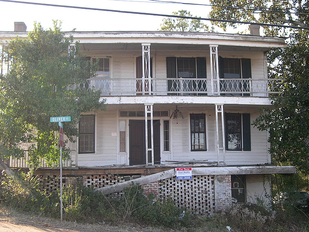 The Neuman-Wright-Dees House, Greenville
The Neuman-Wright-Dees House, Greenville(Alabama Historical Commission)
Places in Peril 2005: Alabama's Endangered Historic Landmarks
By Melanie Betz Gregory and Ellen Mertins
This annual collaboration between the Alabama Historical Commission and the Alabama Preservation Alliance once again brings the state’s threatened landmarks to the forefront. This year’s list includes historic homes in Greenville, Selma, Tuskegee, Hartselle, and Eufaula, along with historic gas stations statewide. Alabama’s first public school building, Mobile’s Barton Academy, and one of its oldest cotton gin plants, Prattville’s Old Pratt Gin Factory, also found their way to the Places in Peril list. Homewood’s Rosedale Park Historic District, Clay’s Ware House and Barn, Oxford’s Davis farm complex, and Coatopa’s Christian Valley Baptist Church round out the list of endangered historic places for 2005.
To Get Involved
Since 1994, the Alabama Historical Commission and the Alabama Preservation Alliance have joined forces to sponsor “Places in Peril”, a program that each year highlights some of the state’s significant endangered properties. As awareness yields commitment, and commitment yields action, these endangered properties can be saved and returned to their important place as treasured landmarks. The “Places in Peril” program has helped to save many important landmarks that may otherwise have been lost. These include the Forks of Cyprus ruins in Florence (listed 1997), the John Glascock House in Tuscaloosa (listed 2001), the Lowe Mill Village in Huntsville (listed 2002), the Coleman House in Uniontown (listed 2003), and Locust Hill in Tuscumbia (listed 2004).
Everyone can play a role to help save those resources that are in peril. Adopt one of the properties. Tell everybody you know that it is important. Write letters of support. Volunteer time or expertise to the local preservation group. If one of the places really strikes you, go ahead and buy it! A generous (or even modest) donation to the “Endangered Property Trust Fund” can help statewide. For more information on the fund or joining the Alabama Preservation Alliance, call 334-834-2727 or email. For Additional information on the “Places in Peril” program, visit the Alabama Historical Commission website or contact Melanie Betz at 334-242-3184.
Additional Information
The following articles in the Encyclopedia of Alabama will also be of interest:Multimedia:
About the Authors
Melanie Betz Gregory joined the staff of the Alabama Historical Commission in the fall of 1989. A native of Illinois, she holds a B.A. in art history from Western Illinois University and a M.A. in architectural history and historic preservation from the University of Virginia. Ms. Gregory is currently working with the Endangered Properties program.
Ellen Mertins currently serves as Director of Outreach for the Alabama Historical Commission. She joined the staff in 1970. She has a B.A. in history from Tulane University.
By Melanie Betz Gregory and Ellen Mertins
This annual collaboration between the Alabama Historical Commission and the Alabama Preservation Alliance once again brings the state’s threatened landmarks to the forefront. This year’s list includes historic homes in Greenville, Selma, Tuskegee, Hartselle, and Eufaula, along with historic gas stations statewide. Alabama’s first public school building, Mobile’s Barton Academy, and one of its oldest cotton gin plants, Prattville’s Old Pratt Gin Factory, also found their way to the Places in Peril list. Homewood’s Rosedale Park Historic District, Clay’s Ware House and Barn, Oxford’s Davis farm complex, and Coatopa’s Christian Valley Baptist Church round out the list of endangered historic places for 2005.
To Get Involved
Since 1994, the Alabama Historical Commission and the Alabama Preservation Alliance have joined forces to sponsor “Places in Peril”, a program that each year highlights some of the state’s significant endangered properties. As awareness yields commitment, and commitment yields action, these endangered properties can be saved and returned to their important place as treasured landmarks. The “Places in Peril” program has helped to save many important landmarks that may otherwise have been lost. These include the Forks of Cyprus ruins in Florence (listed 1997), the John Glascock House in Tuscaloosa (listed 2001), the Lowe Mill Village in Huntsville (listed 2002), the Coleman House in Uniontown (listed 2003), and Locust Hill in Tuscumbia (listed 2004).
Everyone can play a role to help save those resources that are in peril. Adopt one of the properties. Tell everybody you know that it is important. Write letters of support. Volunteer time or expertise to the local preservation group. If one of the places really strikes you, go ahead and buy it! A generous (or even modest) donation to the “Endangered Property Trust Fund” can help statewide. For more information on the fund or joining the Alabama Preservation Alliance, call 334-834-2727 or email. For Additional information on the “Places in Peril” program, visit the Alabama Historical Commission website or contact Melanie Betz at 334-242-3184.
Additional Information
The following articles in the Encyclopedia of Alabama will also be of interest:Multimedia:
About the Authors
Melanie Betz Gregory joined the staff of the Alabama Historical Commission in the fall of 1989. A native of Illinois, she holds a B.A. in art history from Western Illinois University and a M.A. in architectural history and historic preservation from the University of Virginia. Ms. Gregory is currently working with the Endangered Properties program.
Ellen Mertins currently serves as Director of Outreach for the Alabama Historical Commission. She joined the staff in 1970. She has a B.A. in history from Tulane University.
To read about more places in peril, click here for our Places in Peril blog.
DEPARTMENT ABSTRACTS
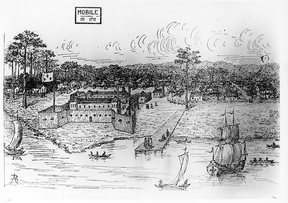 Mobile, c. 1711
Mobile, c. 1711(University of South Alabama Archives)
Alabama Mysteries
Mobile's Anastasia
By Pam Jones
When a royally attired young woman arrived in colonial Mobile claiming to be the Russian Princess Charlotte Christina Sophia of Brunswick-Wolfenbuttel, who was to doubt her? Many, as it turned out, and with good reason: The real Princess Charlotte had reportedly died in 1715 and was buried in a royal tomb in St. Petersburg. Charlotte’s “survival” story, wild as it was, included a fake funeral and flight from an abusive husband, culminating in a trans-Atlantic journey on a ship full of German immigrants. The deception survived until 1765, when her masquerade was exposed by Voltaire himself.
Additional Information
The following articles in the Encyclopedia of Alabama will also be of interest:
About the Author
Pam Jones is a freelance writer in Birmingham with a particular interest in criminal cases from Alabama’s past.
Mobile's Anastasia
By Pam Jones
When a royally attired young woman arrived in colonial Mobile claiming to be the Russian Princess Charlotte Christina Sophia of Brunswick-Wolfenbuttel, who was to doubt her? Many, as it turned out, and with good reason: The real Princess Charlotte had reportedly died in 1715 and was buried in a royal tomb in St. Petersburg. Charlotte’s “survival” story, wild as it was, included a fake funeral and flight from an abusive husband, culminating in a trans-Atlantic journey on a ship full of German immigrants. The deception survived until 1765, when her masquerade was exposed by Voltaire himself.
Additional Information
The following articles in the Encyclopedia of Alabama will also be of interest:
About the Author
Pam Jones is a freelance writer in Birmingham with a particular interest in criminal cases from Alabama’s past.
Southern Architecture and Preservation
Sixteenth Street Baptist Church Gets a Lift
By Aaron Welborn
Most of us know about the tragic Sixteenth-Street Baptist Church bombing of 1963. But how many of us are aware of the second disaster that struck the historic building? Time. One of Birmingham’s most important civil rights landmarks was almost lost to mould, groundwater leakage, and the insidious spread of cracks through the exterior masonry. However, efforts are being made to reverse the damage. In conjunction with the feature story, Places in Peril, Alabama Heritage brings you a story of architectural success.
To Get Involved
If you wish to contribute to the capital campaign to restore and maintain the Sixteenth Street Baptist Church, or if you have questions about the project, feel free to contact them:
Sixteenth Street Foundation Inc.
P.O. Box 2146
Birmingham, AL 35201
205-326-2193
Additional Information
The following articles in the Encyclopedia of Alabama will also be of interest:Multimedia:
About the Author
Aaron Welborn is an assistant editor at Alabama Heritage. Brittani Tingle contributed to this article.
Sixteenth Street Baptist Church Gets a Lift
By Aaron Welborn
Most of us know about the tragic Sixteenth-Street Baptist Church bombing of 1963. But how many of us are aware of the second disaster that struck the historic building? Time. One of Birmingham’s most important civil rights landmarks was almost lost to mould, groundwater leakage, and the insidious spread of cracks through the exterior masonry. However, efforts are being made to reverse the damage. In conjunction with the feature story, Places in Peril, Alabama Heritage brings you a story of architectural success.
To Get Involved
If you wish to contribute to the capital campaign to restore and maintain the Sixteenth Street Baptist Church, or if you have questions about the project, feel free to contact them:
Sixteenth Street Foundation Inc.
P.O. Box 2146
Birmingham, AL 35201
205-326-2193
Additional Information
The following articles in the Encyclopedia of Alabama will also be of interest:Multimedia:
- Sixteenth Street Baptist Church
- Sixteenth Street Baptist Church Bombing
- Sixteenth Street Baptist Church
About the Author
Aaron Welborn is an assistant editor at Alabama Heritage. Brittani Tingle contributed to this article.
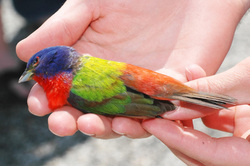 A painted bunting
A painted bunting(W. Mike Howell)
Nature Journal
Birding Dauphin Island
By L. J. Davenport
Spring migration to Dauphin Island is a pilgrimage for birdwatchers, as well as for the birds themselves. The island is one of the most heavily trafficked bird migration sites on the continent, bringing in more than 180 avian species during peak season, including the rare and illustrious painted bunting. Bird fanatics gather here in equal numbers, hoping for a glimpse of this rare, bright-feathered jewel.
Additional Information
For more information on Dauphin Island, or to plan your own birding trip, visit:
The following articles in the Encyclopedia of Alabama will also be of interest:
About the Author
Larry Davenport is a professor of biology at Samford University, Birmingham, Alabama.
Birding Dauphin Island
By L. J. Davenport
Spring migration to Dauphin Island is a pilgrimage for birdwatchers, as well as for the birds themselves. The island is one of the most heavily trafficked bird migration sites on the continent, bringing in more than 180 avian species during peak season, including the rare and illustrious painted bunting. Bird fanatics gather here in equal numbers, hoping for a glimpse of this rare, bright-feathered jewel.
Additional Information
For more information on Dauphin Island, or to plan your own birding trip, visit:
The following articles in the Encyclopedia of Alabama will also be of interest:
About the Author
Larry Davenport is a professor of biology at Samford University, Birmingham, Alabama.
